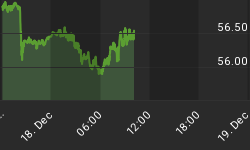1/5/2011 9:22:45 AM
It is time to place your bet...
Recommendation:
Sell shares of DIA short at the close if the price is above the open price on Wednesday and below $116.64.
Sell shares of QQQQ short at the close if the price is above the open price on Wednesday and below $55.27.
Sell shares of SPY short at the close if the price is above the open price on Wednesday and below $126.98.
Daily Trend Indications:

- Positions indicated as Green are Long positions and those indicated as Red are short positions.
- The State of the Market is used to determine how you should trade. A trending market can ignore support and resistance levels and maintain its direction longer than most traders think it will.
- The BIAS is used to determine how aggressive or defensive you should be with a position. If the BIAS is Bullish but the market is in a Trading state, you might enter a short trade to take advantage of a reversal off of resistance. The BIAS tells you to exit that trade on "weaker" signals than you might otherwise trade on as the market is predisposed to move in the direction of BIAS.
- At Risk is generally neutral represented by "-". When it is "Bullish" or "Bearish" it warns of a potential change in the BIAS.
- The Moving Averages are noted as they are important signposts used by the Chartists community in determining the relative health of the markets.
Current ETF positions are:
In cash.
Daily Trading Action
The major index ETFs opened higher and immediately began a descent that would last through the morning session finally finding an intraday botton at about a quarter until 1:00pm. From there, the major indexes retraced their losses and finished mixed. The Russell-2000 (IWM 78.42 -1.18) lost one and one half of one percent. The Semiconductor Index (SOX 415.58 +0.53) closed little changed. The Bank Index (KBE 26.42 -0.08) lost a modest amount while the Regional Bank Index (KRE 26.48 -0.49) lost nearly two percent. The Longer-term bonds (TLT), the Rusell-2000, the Semiconductor Index, and the Regional Bank Index are all in trading states while the other indexes we regularly monitor are in uptrend states. The 20+ Yr Bonds (TLT 93.52 +0.11) added modest gains to remain above its 20-Day Moving Average (DMA) but finishing just below horizontal resistance. NYSE volume moved back to above average with 1.094B shares traded. NASDAQ volume was also above average with 2.007B shares traded.
There was a single economic report of interest released:
- Factory Orders (Nov) rose +0.7% versus an expected -0.3% fall
In addition to the lone economic report, the Fed released the minutes from the last meeting of the FOMC (Fed Open Market Committee) at 2:00pm and it didn't reveal anything particularly meaningful. In point of fact, members seem disappointed with the slow progress, but note that the economy continues to improve.
The U.S. dollar opened lower but rallied through the day to close up nearly three tenths of one percent.
Implied volatility for the S&P-500 (VIX 17.38 -0.23) fell more than one percent and the implied volatility for the NASDAQ-100 (VXN 18.90 -0.17) fell nearly one percent.
The yield for the 10-year note rose six tenths of a basis point to close at 3.346. The price of the near term futures contract for a barrel of crude oil fell $2.17 to close at $89.38.
Market internals were negative with decliners leading advancers 7:4 on the NYSE and by more than 2:1 on the NASDAQ. Down volume led up volume 13:10 on the NYSE and by 9:8 on the NASDAQ. The index put/call ratio fell 0.07 to close at 1.04. The equity put/call ratio rose 0.04 to close at 0.44. The level of complacency is high.
Commentary:
Tuesday was all about a head fake. In this case, traders opened the market higher and then took it for a nice dive with the S&P-500 and NASDAQ-100 finishing lower and the Dow managing a small gain. However, all of them finished lower than their higher opens. The Russell-2000, emblematic of the risk trade, dropped nearly 1.6% on the day after selling off more than two percent at its intraday low, which was also below its 20-DMA. It had opened on its upper Bollinger Band and saw only downside from there leaving behind a big red candle. Still, the Semiconductor Index was able to manage a small gain.
So what does it mean? It means the market is likely to make a corrective move here, with the market likely to open down on Wednesday but likely to finish higher. We will enter a short trade at the close, assuming the market closes higher than it opens and below Tuesday's closing price. Enter your conditional orders accordingly.
We hope you have enjoyed this edition of the McMillan portfolio. You may send comments to mark@stockbarometer.com.















